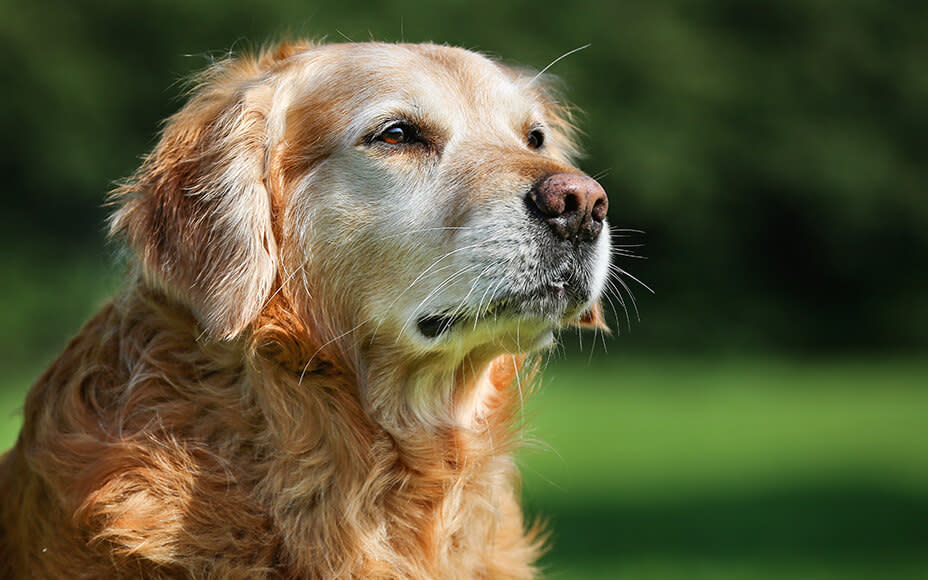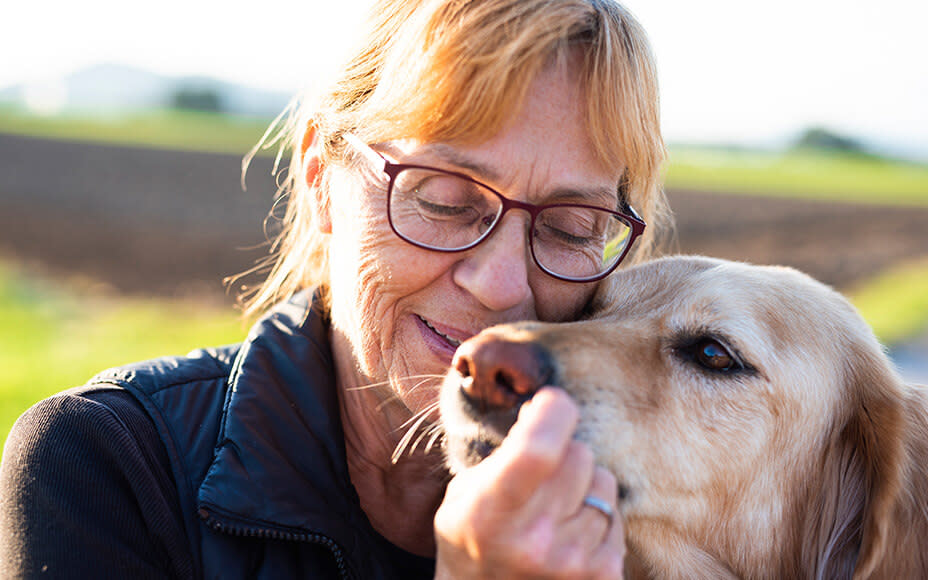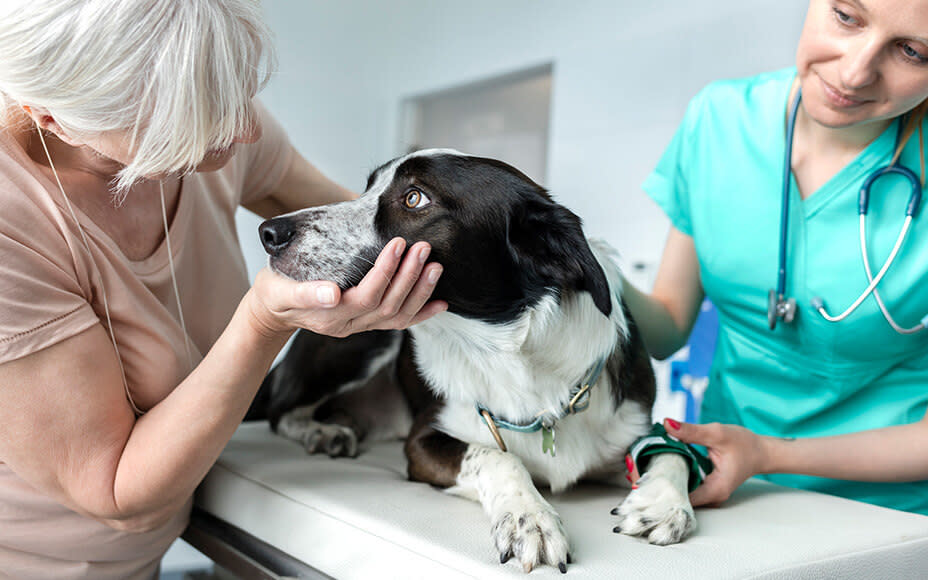Learn how to recognize signs of age-related weakness in your dog and discover tips to support your four-legged senior companion.
Age-Related Weakness in Dogs
Our beloved furry companions often accompany us for many years, sometimes since their puppy days. If you notice that the fur is slowly turning gray, you might wonder where the time has gone and whether your canine friend is already considered a senior dog. We’ll show you the signs of age-related weakness in your dog, how to recognize them, and offer tips to support your four-legged senior.
When Does My Dog Become a Senior?
Aging affects our beloved pets just like it does humans. But when is the time that your dog is considered a senior, and how long do dogs generally live?
In general, small dogs usually have a longer life expectancy than large ones. Therefore, large breeds like Great Danes or Saint Bernards are considered seniors around 6-7 years old, with an average life expectancy (depending on size) of 8-13 years. Small breeds such as Jack Russells or Chihuahuas are considered seniors around 10-11 years old, with an average life expectancy of 10-15 years.

A healthy and balanced diet is crucial for keeping your dog fit into old age. Additionally, wet food is often the preferred choice for older dogs. In our products, we completely avoid gluten-containing grains, sugar, flavor enhancers, and dyes. Instead, our food shines with high-quality ingredients, gently cooked vegetables, fresh fruit, and rich oils and herbs. Give it a try!
How Does Age-Related Weakness Manifest in My Dog?
The signs of age-related weakness can vary for each furry friend. Some dogs may show hardly any signs even in their old age, while others may struggle with aging early on.
The following manifestations can be indicators of age-related weakness:
- Graying of the fur, especially in the facial area
- Gradual decline in vision, hearing, and sense of smell
- Less enthusiasm for long walks
- More resting periods
- Bladder weakness
What Diseases Are Common in Senior Dogs?
In general, aging is not a disease, but unfortunately, getting older often comes with age-related diseases.
The following diseases are more common in old age:
- Joint diseases like arthritis
- Heart diseases like heart cough
- Kidney diseases
- Liver diseases
- Dental issues like tartar
- Metabolic diseases like Cushing’s disease, diabetes mellitus, or hypothyroidism
- Weight gain or weight loss
- Uterine inflammation (in unspayed females)
- Dementia

How Can I Best Support My Senior Dog?
Naturally, your dog will change with age and become calmer, much like aging humans. However, this doesn’t mean that the joy of being a dog is over.
Here are some tips on how to best support your furry friend in their senior years:
Patience
One of the most crucial tips for living with a senior dog is to have patience and understanding. Life with an old dog is different from life with a puppy.
Be patient when walks are slower than before. Don’t be upset if the bladder doesn’t hold until the next walk. Show understanding if your dog doesn’t come running at your first call, like in the past.
Regular Veterinary Checkups
As you’ve learned, some diseases are more common in old age, and some signs of age-related weakness could also be early symptoms of illness. Regular veterinary checkups are essential in old age to detect and treat potential diseases early.
Increased urination, for example, could be due to age-related bladder weakness, but it could also be a symptom of diseases such as diabetes mellitus, bladder infections, or Cushing’s disease.
Less interest in long walks might either be a sign of age-related reduced activity or a symptom caused by pain due to arthritis or other orthopedic issues that need veterinary attention. Our Joint Tabs are ideal for supporting joint metabolism in osteoarthritis.
A diminished sense of smell can lead to a reduced appetite. If your furry friend suddenly refuses to eat, seek veterinary advice to rule out causes like mouth area inflammation or pain.
You know your dog best: Don’t always accept sudden behavioral changes as normal signs of aging; have your beloved companion examined by a vet.

Feeding Senior Dogs
A senior dog relaxing most of the time has a lower energy requirement than a young dog that would love to play around all day. Pay attention to your dog’s weight and adjust the feeding amount accordingly. Overweight dogs are more prone to diseases like diabetes, and joints suffer from excess weight.
Our “Vet” Joint Wet Food is perfectly tailored to the needs of older dogs and supports joint metabolism.
Unlike weight gain due to lower energy needs, some older dogs experience a decreased sense of taste and smell, leading to a reduced appetite. In such cases, it may be helpful to mix the food with a bit of warm water or flavor-enhancing salmon oil. Salmon oil not only tastes delicious but is also rich in Omega-3 fatty acids, which can support joint health.
Feeding from an elevated food bowl eases joint strain and is preferred by some dogs with arthritic problems.
Senior-Friendly Walks
The saying “Use it or lose it” might apply here. Exercise is important for old dogs, but you shouldn’t organize hours-long hikes for your senior companion. Adjust the walks to your dog’s activity level. Take breaks, and use these pauses for plenty of cuddles.
If your senior dog gets stressed by lively young dogs, try to avoid such encounters. This way, you spare your furry friend unnecessary stress. However, contact with well-tolerated dogs and familiar four-legged friends should not be neglected.

As winter approaches and temperatures drop, always make sure your senior dog stays warm. Even if your dog had no problems with freezing cold in their younger years, cold tolerance often decreases with age. If you feel your dog is cold, consider putting on a coat. The selection is vast, so it’s best to get advice from a specialist store.
Senior-Friendly Home
Many elderly dogs find it challenging to climb stairs with weary joints. You should assist your aged companion with this task. Small dogs can often be carried, while there are special aids for large dogs available in pet stores to help them climb stairs.
Non-slip floors make it easier for your senior dog to explore your home. You can use runners with anti-slip backing on particularly slippery spots.
As you’ve learned, eyesight often diminishes with age. However, our furry friends usually find their way around the house well. If you rearrange furniture or make changes in the house, try to gently acclimate your dog to it. Use your voice and physical contact to show them where new things are.
To keep your dog mentally sharp, they’ll likely enjoy a few intelligence games. Hiding treats or feeding from an intelligence toy are good ways to keep your furry friend mentally active even in old age.


